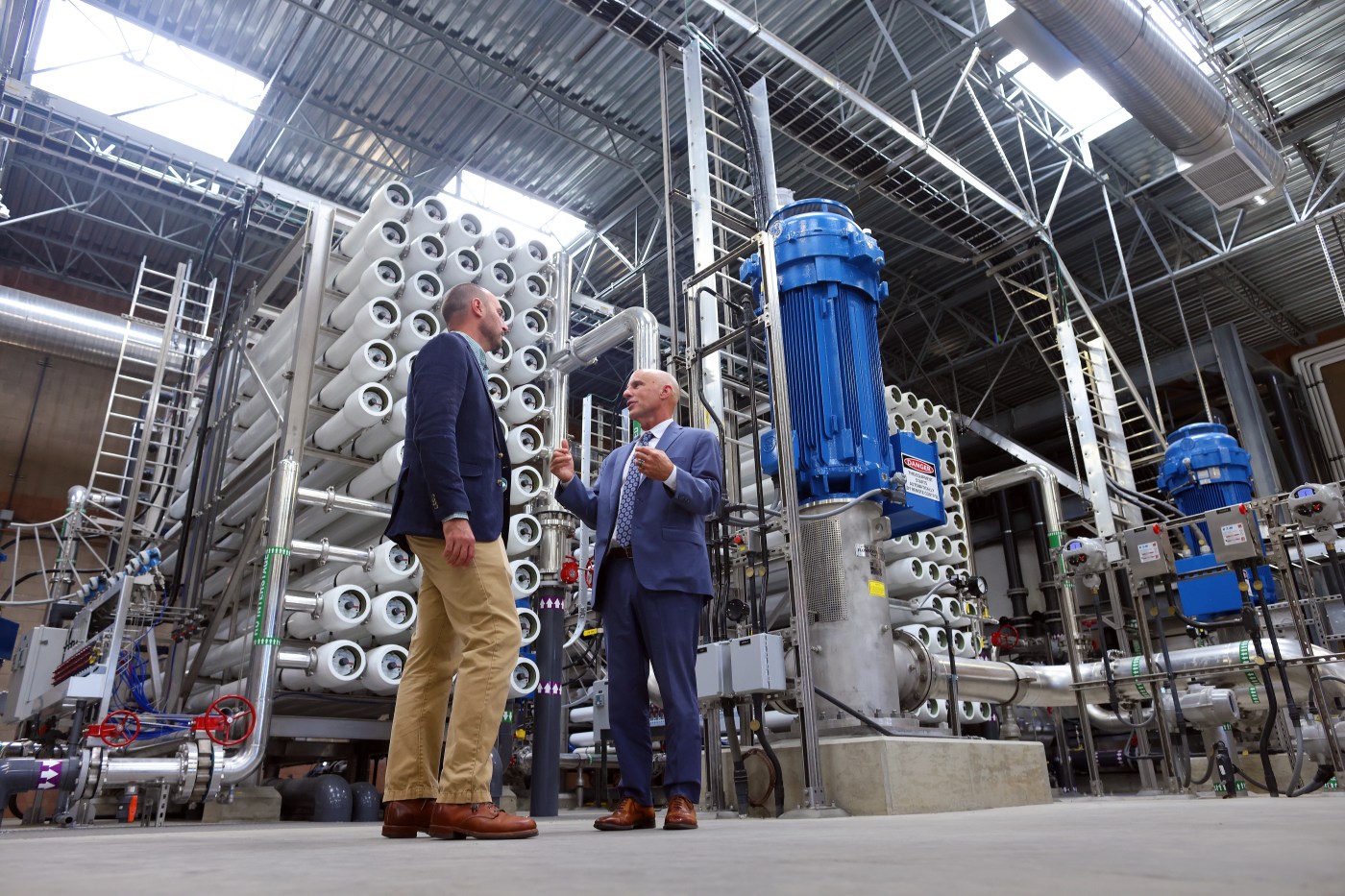ANTIOCH – Antioch has finally turned on the taps of its long-awaited brackish water desalination plant, which is expected to help the city safeguard its water supply for decades to come.
The $160 million facility, hailed by city leaders as a milestone in California’s water sustainability efforts, will meet up to 40% of Antioch’s water needs.
Residents and businesses use up to 11 million gallons of water daily in the winter and 23 million in the summer. With the plant in service, the city can treat and convert into drinking water about 6 million gallons a day of brackish water pumped from the Sacramento-San Joaquin River Delta.
Water treatment plant Superintendent Marcus Woodland, left, presses a start button at the city’s new Brackish Water Treatment Plant on Monday, Sept. 15, 2025, in Antioch, Calif. The plant is designed to supply up to 40% of Antioch’s drinking water, using energy-efficient, low-waste technology to treat brackish water from the Delta. (Aric Crabb/Bay Area News Group)
Related Articles
Opinion: Newsom must protect California’s drinking water from microplastics
Wildfire threats to California water resources demand attention, group warns
EBMUD adopts new UV light technology to combat water quality threats
‘Spirit of optimism’ as Richardson Bay restoration progresses
Pickett Fire containment rises to 21% as Napa County issues health emergency over debris
The city has already been pumping as much water as possible from the river; however, because of an increase in saltwater levels over the years, it has been unable to do so during the summer and fall. To fill the gap, Antioch purchases more expensive water from the Contra Costa Water District to fulfill the needs of some of its 110,000 residents.
“This project not only provides critical supplies for Antioch’s health and safety needs during severe drought, but also improves drought supplies for our neighboring communities and members of the Contra Costa Water District,” Mayor Ron Bernal said at a ribbon-cutting ceremony on Monday.
He hailed the completed project as the largest infrastructure investment in the city’s history. “This vast undertaking represents nine years and over $100 million of state financing, complete extensive environmental studies, and federal and state permits to protect endangered and threatened species,” Bernal said.
The desalination plant project broke ground in 2022 with Gov. Gavin Newsom in attendance. The governor said the plant was part of his plan to help California overcome worsening droughts and water shortages because of climate change through an array of new desalination plants, reservoirs and recycled water projects.
State officials have estimated California’s water supply could be reduced by up to 10% by 2040 due to hotter and drier weather.
State Water Resources Control Board Chairman E. Joaquin Esquivel said that with drought a constant threat, California cities need to be prepared for the future.
State Senator Timothy Green, right, speaks during a ceremony at a new Brackish Water Treatment Plant on Monday, Sept. 15, 2025, in Antioch, Calif. The plant is designed to supply up to 40% of Antioch’s drinking water, using energy-efficient, low-waste technology to treat brackish water from the Delta. (Aric Crabb/Bay Area News Group)
“We have 19th-century laws with 20th-century infrastructure challenges,” Esquivel said. “This is an example of the 21st-century infrastructure that we are going to need to help secure this community’s access to water for decades to come.”
Located south of Highway 4, the desalination facility is within the current water treatment plant area. It includes a 4.3-mile pipeline from the plant to the Delta Diablo Wastewater Treatment plant, where the remaining brine from the desalination – a process of removing minerals and salts from water to produce purified water by pushing water at a high pressure through a reverse osmosis membrane – is sent and discharged to the river.
Among those joining city councilmembers for Monday’s ceremony were State Sen. Tim Grayson; Assemblymember Anamarie Avila Farias; Contra Costa County Supervisor Diane Burgis; and Brentwood Mayor Susannah Meyer.
Grayson also praised city officials for having the foresight to collaborate with local, regional, and state agencies.
“You were able to bring resources, you were able to bring technology, you were able to bring the partnerships together to eventually get something done for Californians, California, and this part of the Bay Area, so thank you very much for your tenacity,” Grayson said.
After being conceived in the 2010s, the desalination plant got a huge boost in 2018 when California water officials awarded the project $10 million from Proposition 1, the state water bond passed in 2014. Other funding included a $60 million low-interest loan from the State Water Resources Control Board’s Drinking Water State Revolving Fund, $27 million from a state Department of Water Resources settlement agreement regarding water rights and from Antioch’s Water Enterprise Fund.
Bernal said the new plant will benefit Antioch not only as a reliable and affordable water source, but also as an engine for growth.
“It will benefit the city when we attract businesses and industries that depend on an uninterrupted source of water,” he told Bay Area News Group, “especially during severe drought conditions.”
A drone view of the new desalination plant on Putnam Street in Antioch, Calif., on Thursday, Jan. 2, 2025. (Jane Tyska/Bay Area News Group)
A drone view of the new desalination plant on Putnam Street in Antioch, Calif., on Thursday, Jan. 2, 2025. The nearly $100-million brackish desalination plant is expected to start operating within the next few months. (Jane Tyska/Bay Area News Group)
A drone view of the new desalination plant in a residential area near Putnam Street in Antioch, Calif., on Thursday, Jan. 2, 2025. The nearly $100-million brackish desalination plant is expected to start operating within the next few months. (Jane Tyska/Bay Area News Group)
Water pipelines at the new Brackish Water Treatment Plant on Monday, Sept. 15, 2025, in Antioch, Calif. The plant is designed to supply up to 40% of Antioch’s drinking water, using energy-efficient, low-waste technology to treat brackish water from the Delta. (Aric Crabb/Bay Area News Group)





